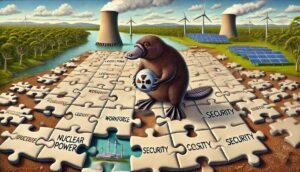Coal generator retirements are supposed to be good news for wind and solar projects. But in a quirk of the nature of power flows on the grid, the impending closure of the last unit at the Liddell coal plant spells bad news for some of the country’s pioneering solar and wind projects.
The 57MW Moree solar farm, one of the first large scale solar projects in Australia, and the first to install solar trackers (nearly every other solar farm since has followed the same path) has had its so called “marginal loss factors” significantly downgraded in the latest draft assessment by the Australian Energy Market Operator.
Others to be badly affected include White Rock, one of the first co-located wind and solar projects in the country, and a bunch of other large solar projects located in the northern half of NSW, some of whom have had their MLFs downgraded by more than six per cent.
The reason is the changing nature of power flows in the grid. Liddell is closing in the Hunter Valley, but some of that capacity is expected to be filled by increased output flowing down from the mostly state-owned coal generators in central Queensland, helped by augmented transmission lines.
This in turn is crowding out the wind and solar farms located in northern NSW, and also in north Queensland. By a quirk of the way these things are calculated, it is their output that is downgraded.
“Material decreases in MLF outcomes within northern New South Wales, largely driven by a forecast increase in local generation capacity (driven by new generation) and a material increase in forecast imports from Queensland.,” AEMO says in its latest draft assessment.
“The increased imports from Queensland are primarily being driven by forecast increases in the output of thermal generation within central Queensland compounded by an increase in the transfer capacity of NSW-QLD in both directions.”
An MLF is an assessment of how much of a generator’s output should be credited as “delivered” and revenue earning on the market. The MLFs can be affected by the amount of generation at a particular spot, the amount of load, and transmission flows.
An MLF of 1.0 means all is good, and all the output is credited. An MLF of 0.8 means that 20 per cent of a generator’s output is deemed as lost and can’t be counted for revenue purposes.
Moree’s MLF has been downgraded from an already lousy 0.8275 to just 0.7825 for the 2023/24 fiscal year, which as far as RenewEconomy can tell is the lowest anywhere in Australia’s main grid.
It now ranks behind the 200MW Silverton wind farm near Broken Hill which actually gets an upgrade from 0.7973 to 0.8173, and the 50MW Broken Hill solar farm – both victims of a lack of local load and a long thin line to the rest of the grid, although their future may be rosier with a new battery and a planned renewable microgrid and local long duration storage.

Others to be badly affected include the co-located White Rock wind and solar farms (from 0.8697 to 0.8184), the Metz solar farm (from 0.8831 to 0.8311), and the New England solar farms now under construction (from 0.9007 to 0.8559). All these projects are effectively facing a revenue cut of at least five per cent.
Projects in central and north Queensland are also materially affected, again because of the anticipated increased output from the big – and mostly state owned – coal generators in central Queensland.
Among those worst affected are the Kidston, Collinsville, Clermont, Moura, Middlement, Ross River, Hayman, Haughton, Hamilton, Daydream and Rugby Run solar farms.
The country’s first grid connected wind, solar and battery project, the Kennedy Energy Park, is also badly affected. The average losses for these projects appear limited to around three per cent.
It should be noted that big coal generators such as Callide and Gladstone have suffered similar reductions in their MLFs.
Other wind and solar projects around the country are faring better, thanks to changing grid flows in their favour. These include those located in the west and south west of NSW (Finley, Darlington Point, Wellington), and those in north-west Victoria (thanks to increased local demand).
In South Australia the story is mixed, as those in the south-east of the state benefit from increased exports to Victoria via the Heywood interconnector, and those in the north of the state suffer due to increased imports via MurrayLink.
The worst affected appears to be the Dalrymple North battery, which has a big downgrade on its generation side (from 0.9432 to 0.9007), which seems surprising as it is ostensibly designed to serve the local area.
Some Tasmania projects have had their MLFs downgrade, mostly due to reduced imports into Victoria from the sub-sea BassLink.










